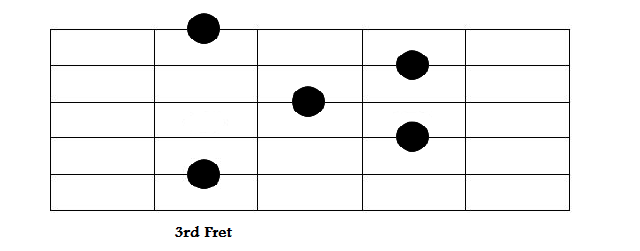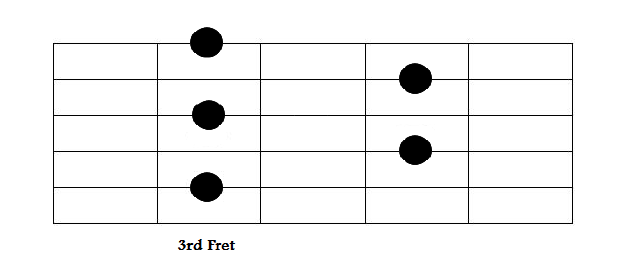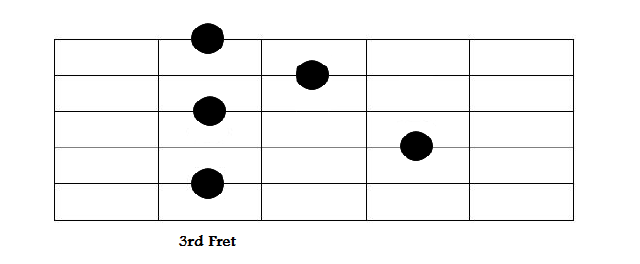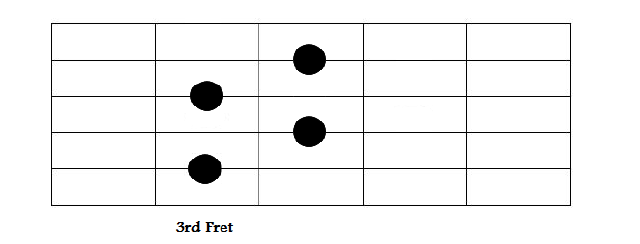The minor pentatonic scale is probably the most well known scale to modern guitar players, it’s simple shape is easy to remember and comfortable to navigate across the guitar. For that reason, it is incredibly useful, especially during improvisation. However, we only really scrape the surface on the usefulness of this scale, and this article provide another use for us to explore.
Pentatonic substitution is the process of superimposing the minor pentatonic scale over an alternative degree of an underlying chord in a given progression. The effect of this is that we highlight certain intervals against a chord, giving character to our note selection.
The following examples will be based on C chords, so for reference, the notes and intervals of C Major are below:
Let’s start off by looking at a Cmaj7 chord:
The intervals of a Cmaj7 chord are: I – III – V – VII
If we play a minor pentatonic scale off the third degree (E), we get the following intervals:
III – V – VII – IX – XIII
You may notice, that the root note C, is omitted from our note selection. This in itself will remove the predictability of the melody being produced, as the resolving nature of the tonic note is not played. However, we have still included all the remaining chord tones, as well as introducing the 9th and 13th extensions, giving this option a rich yet inside feeling.
Let’s next look at a C7 Chord:
The intervals of a C7 chord are: I – III – V – VIIb
If we play a minor pentatonic scale off the fifth degree (G), we get the following intervals:
I – V – VIIb – IX – XI
Using this option, we remove the third interval, however retain the root, fifth, and characteristic dominant seventh interval. We also add the ninth and eleventh extensions, adding a bit of spice and tension to the harmony created.
Now let’s look at a Cmin7 chord:
The intervals of a Cmin7 chord are: I – IIIb – V – VIIb
If we play a minor pentatonic scale off the fourth degree (F), we get the following intervals:
I – IIIb – VIIb – XI – XIIIb
This option, whilst omitting the fifth interval, really highlights the minor tonality of the chord.
The eleventh extension gives texture, whilst the flattened thirteenth adds a true aeolian feel. It’s worth noting that this is only one note different from the obvious option of playing a standard C minor pentatonic scale, in that we have traded the fifth interval for the flattened thirteenth, adding a touch more tension to the sound.
Finally, let’s look at a Cmin7b5 chord:
The intervals of a Cmin7b5 chord are: I – IIIb – Vb – VIIb
If we play a minor pentatonic scale off the minor third degree (Eb), we get the following intervals:
IIIb – Vb – VIIb – IXb – XIIIb
This option, omits the root note, however it does not feel missed. Having every interval flattened, gives a strong diminished effect to this scale choice, and highlights the dark sounding nature of the min7b5 chord.
There are of course other options to those suggested above, and certain choices will work better in certain situations. This is a great concept to get into, and an ideal entry into the practice of superimposition. It is a very useful tool for writing interesting harmonies, and improvising over quick chord changes and complex modulations.
Explore the concept further by experimenting with other options, superimposing the minor pentatonic scale off alternate intervals. See what extensions are created, and compare with any modal knowledge you may previously have studied.
Article by Adi Hughes. See more from Adi here: www.adihughes.co.uk








